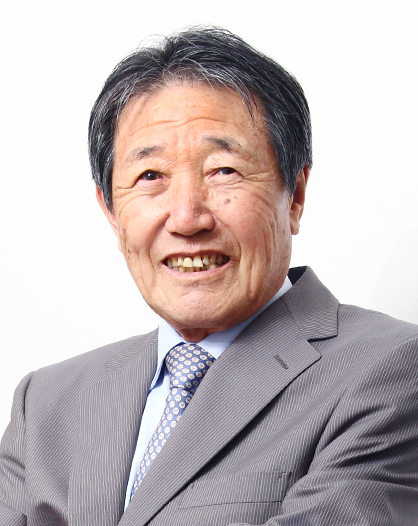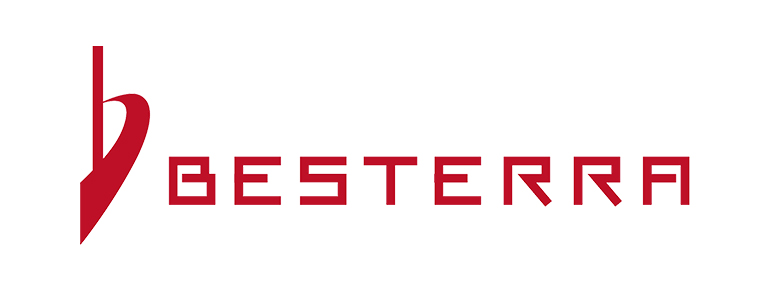| BESTERRA CO., LTD (1433) |
|
||||||||
Company |
BESTERRA CO., LTD |
||
Code No. |
1433 |
||
Exchange |
Tokyo Stock Exchange, First Section |
||
Industry |
Construction business |
||
President |
Yoshihide Yoshino |
||
Address |
4-24-3 Kotobashi, Sumida-ku, Tokyo |
||
Year-end |
January |
||
URL |
|||
* The share price is the closing price on September 12.
|
||||||||||||||||||||||||
|
|
*The forecasted values were provided by the company. The term ended Jan. 2014 is 9 months, because the accounting period has been changed.
*The company split its stock 4 for 1 in May 2015, 2 for 1 in Feb. 2016, and 3 for 1 in Feb. 2017 (EPS has been revised retroactively). This Bridge Report reviews on the outlook of BESTERRA for the first half ending Jan. 2018 and full year 2018. |
| Key Points |
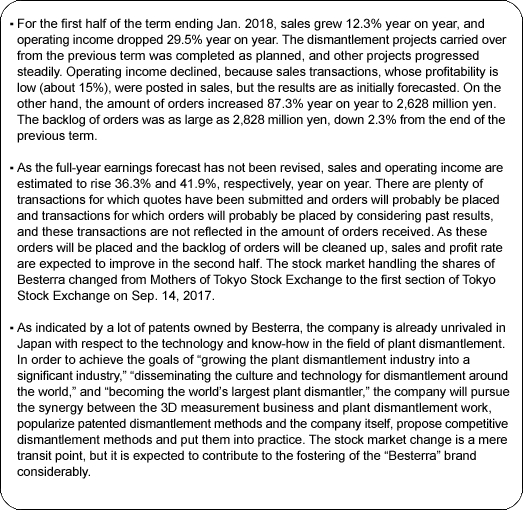 |
| Company Overview |
|
Code of conduct
We will fulfill our responsibilities as professionals. We constantly develop new technologies, "put a higher priority on safety than anything else," and offer our services to clients while increasing assurance under the motto "Swifter, more affordable, and safer." 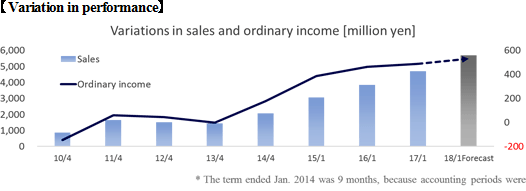 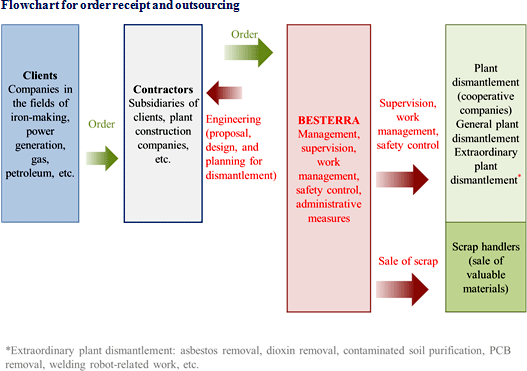 The company is also ensuring that it does not directly own heavy machinery and workers for construction. This management style allows it to flexibly deal with the dismantlement of any facilities of plants that have complicated structures. * Concerning 2 revenue recognition methods and seasonality of revenue recognition.
There are 2 revenue recognition methods for construction contracts: 1) a completed-contract (CC) method in which revenue is recorded at the end of the construction, and 2) a percentage-of-completion (PC) method in which revenue is recorded as construction progresses. For the projects from which valuable materials, such as scrap, are generated through plant dismantlement, the company has been using the PC method only for the projects for which the contract amount exceeds 50 million yen, the construction period is longer than 3 months, and sales estimates of scrap, etc. is less than 10% of the total contract amount, because the revenue from the construction cannot be determined until the last moment when scrap is sold. Meanwhile, the timing of revenue recording (completion of construction) using the CC method is often influenced by facility investment plans of the clients. In case of the company, the revenue is often recorded during the first quarter (February to April) and the fourth quarter (November to January) (seasonality of revenue recognition). With this method, however, changes of quarterly results may mislead investors. Therefore, for large-scale projects for which the contract amount exceeds 50 million yen and the construction period is longer than 3 months, the company decided to use, in principle, the PC method from the fiscal year ending January 2018. This may not eliminate the seasonality of revenue recognition but will lead to leveling of revenue recognition.
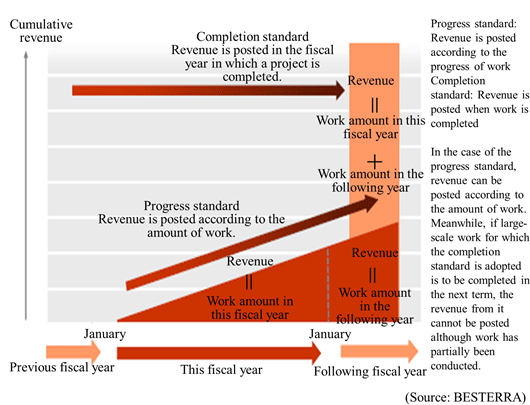 |
| First Half of Fiscal Year January 2018 Earnings Results |
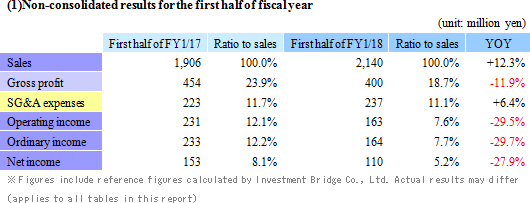 Sales grew 12.3% year on year, while operating income dropped 29.5% year on year.
Sales were 2,140 million yen, up 12.3% year on year. The dismantlement projects carried over from the previous term was completed as planned, and other projects progressed steadily. The amount of completed projects was 2,103 million yen, up 12.4% year on year. (The sales of other business, including staffing services, increased 5.7% year on year to 37 million yen).As for the breakdown of completed projects, petroleum and mineralization plant dismantlement accounts for 42% (15% in the term ended Jan. 2017) as the dismantlement of ethylene production equipment was completed, iron-making 35% (56% in the term ended Jan. 2017), electric power 13% (20%), gas 7% (5%), and others 3% (4%). Operating income was 163 million yen, down 29.5% year on year. While cost rate worsened as large-scale projects whose profit rate is low were completed and their sales were posted, SG&A expenses augmented due to the strengthening of personnel (3D engineers and construction supervisors; a total of 8 workers newly employed) and active sales activities. Cost of sales grew 19.9% year on year to 1,739 million yen, because of the increases in outsourcing cost (up 54 million yen), labor cost (up 26 million yen, 7 employees newly employed in the construction section), and other cost (26 million yen). The number of members of the construction section (hands-on supervisors) as of the end of the first half was 29 (22 as of the end of the previous term). The amount of orders received grew 87.3% year on year to 2,628 million yen. It increased mainly in the electric power field, in which the company strives to streamline its business operation. Accordingly, the backlog of orders was reduced steadily, but the backlog of orders as of the end of the first half was as large as 2,828 million yen (down 2.3% from the end of the previous term). As for the breakdown of the backlog of orders, electric power accounts for 47% (13% at the end of the same period of the previous year), iron-making 30% (69%), petroleum and mineralization 6% (15%), gas 17% (1%), and others -% (2%). 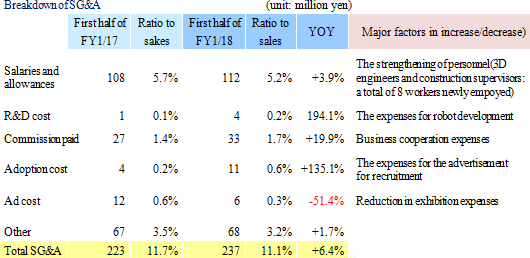   Profit rate dropped temporarily due to specially regulated transactions
Sales grew 28.4% year on year to 1,297 million yen, because the amount of completed projects increased 28.9% year on year to 1,281 million yen. Sales grew, but operating income declined, as large-scale projects whose profit rate is low were completed and their sales were posted. The amount of orders received increased 158.7% year on year to 2,256 million yen, as the company made efforts to make new transactions considering the steady progress of ongoing dismantlement projects.  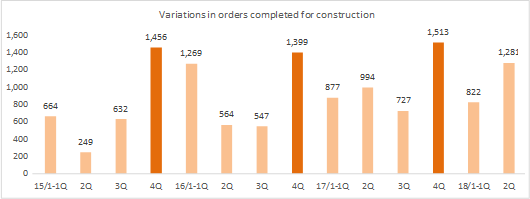  On Apr. 4, 2017, the company issued stock options with charge, and from Apr. 6 to 11, 2017, the company sold 100,000 shares through off-floor trading, in order to improve the share distribution and liquidity considering the market shift to the main section of Tokyo Stock Exchange (the shift to the first section of the market is already scheduled to be conducted on Sep. 14). Stock options with charge were issued to executives and employees for the purposes of enhancing their motivation and morale and cementing their bond in order to improve their business performance and corporate value in the medium and long terms.  (4) Results of 3D measurement business The 3D measurement business, which the company is developing, is steadily making achievements in the fields where there is a high synergy effect with the plant dismantlement business. In the plant field, the company has experiences with 3D laser measurement of the entire steel plant using the perfect 3D, which is a collaborative project with Aero Asahi (development of large-scale 3D point group data using the aerial leaser, MMS and fixed scanner), measurement of shaft furnace and steel plant, measurement of various production plants (i.e. food, petrochemical products), displacement measurement of thermal deformation parts before and after operation, and distortion measurement of disaster affected areas. In the field of power supply, the company has experiences such as measurement and modeling of a nuclear power plant, measurement and dismantlement simulation for dismantlement of a thermal power plant, and measurement and dismantlement simulation in association with a hazardous material disposal facility. Furthermore, it has conducted 3D measurement to collect data on transferring local heating and cooling machine room and wooden building as well as urban area road data. (5) Patents of construction methods The company has many patents of construction methods for dismantling tanks, boilers, chimneys and cranes, as shown below. Two 3D-related patents under application are already published. Most recently, it has applied for a patent to dismantle a wind turbine used for wind power generation and a patent for a special construction method that was used for dismantling a facility of Chugoku Electric Company. It will continue proposing competitive dismantling methods using patent construction methods and put them into use. 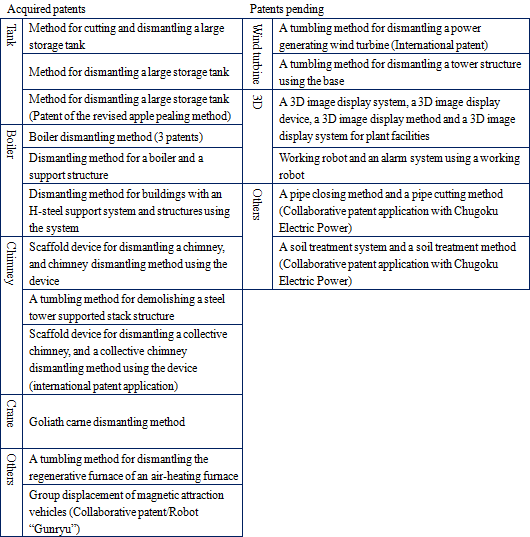 |
| Fiscal Year January 2018 Earnings Estimates |
 There is no revision to the full-year earnings forecast. Sales and operating income are estimated to grow 36.3% and 41.9%, respectively, year on year.
Sales are projected to be 5.7 billion yen, up 36.3% year on year. At the present moment, there are plenty of transactions for which quotes have been submitted and orders will probably be placed and transactions for which orders will probably be placed by considering past results, and these transactions are not reflected in the amount of orders received. As these orders will be placed and their sales will be posted, and the backlog of orders will be cleaned up, sales are expected to improve in the second half.Operating income is forecasted to be 564 million yen, up 41.9% year on year. The augmentation of SG&A expenses, mainly for personnel expenses (No. of employees at the end of the term: 57 → 79), R&D cost (7.6 million yen → 39 million yen), and recruitment cost (11 million yen → 26.5 million yen), was offset by sales growth and the increase in gross profit rate due to the improvement of the advantage of scale and productivity. The stock market handling the shares of Besterra changed from Mothers of Tokyo Stock Exchange to the first section of Tokyo Stock Exchange on Sep. 14, 2017. (2) Policy for distributing profit and return to shareholders
The 3 policies for profit distribution are the "investment for future growth," "internal reserve for fortifying the business base," and "return of 40% of profit to shareholders (dividend)." For the investment for future growth, the company will rationally allocate funds to equipment investment (robots and 3D measurement equipment), investment in technological development (dismantlement methods and robots), investment in systems (3D systems, BIM, and CIM), and strategic business investment (M&A, etc.).For the benefits for shareholders, the company will present a Quo card to shareholders according to the number of shares they hold as of the date of right allotment (end of Jan.) from the term ending Jan. 2018.  |
| Conclusions |
|
The company considers that "structures cannot be dismantled by constructors" and "constructors do not have the idea of harnessing the force of the earth"; in other words, "constructors use a variety of ingenious technologies for construction, but not for dismantlement" and "ingenuity means the flexibility, creativity, and technology for dismantlement." The company earns revenue by consulting and hands-on management utilizing its technology and know-how for plant dismantlement, and so it does not require funds for expanding its business. Accordingly, it was unnecessary to get listed in the stock market, from the viewpoint of funds, but it was listed in the Mothers of Tokyo Stock Exchange in Sep. 2015. This is because the company hoped to "grow the plant dismantlement industry into a significant industry," "disseminate the culture and technology for dismantlement around the world," and "become the world's largest plant dismantler." As indicated by a lot of patents owned by Besterra, the company is already unrivaled in Japan with respect to the technology and know-how in the field of plant dismantlement. In order to achieve the goals, the company will develop the 3D measurement business and pursue the synergy between the 3D measurement business and plant dismantlement work, popularize patented dismantlement methods and the company itself, propose competitive dismantlement methods and put them into practice. The market change to the first section of Tokyo Stock Exchange is a mere transit point, but it is expected to contribute to the fostering of the "Besterra" brand considerably. |
| <Reference: Regarding Corporate Governance> |
 ◎ Corporate Governance Report
Update date: Sep. 15, 2017
Basic Policy
In order to promote sound business administration and win social trust sufficiently, our company recognizes corporate governance as the most important issue, puts importance on the improvement of the soundness, transparency, and fairness of business administration, and complies with laws and regulations thoroughly, and all executives operate business while keeping in mind that "the violation of laws or regulations would lead to management responsibility." In detail, our company disseminates and executes business pursuant to laws, regulations, and in-company rules thoroughly, by developing appropriate systems for making decisions about business administration, fulfilling duties, supervising work, conducting internal control, etc. It is also important to reform management systems for "achieving appropriate share price" and "increasing share price sustainably" to emphasize shareholders and strengthen the function to check business administration, to establish global-level corporate governance. The results of such efforts would win the trust of society, increase corporate value, and satisfy shareholders. <Reasons for Non-compliance with the Principles of the Corporate Governance Code (Excerpts)>
Our company has appointed 2 independent outside directors, who give their opinions to the Board of Directors and each director and, when necessary, offer advice by utilizing their professional knowledge and extensive experiences as corporate managers. Although our company has not established any committees as optional advisory bodies, we consider that, at the moment, our company has successfully received appropriate involvement and advice from the independent outside directors at meetings of the Board of Directors. In our company, the Board of Directors holds a meeting every month in which the Board has discussion and makes decisions timely and properly about important matters set forth in the regulations of the Board of Directors. In addition, the Board regularly receives reports on the business conditions of our company and appropriately oversees risk management and business execution. Regarding important issues, the Board provides prior explanations to outside directors and outside auditors so that sufficient time for animated discussion can be secured during meetings of the Board. We believe that our Board of Directors has been operated effectively as described above, and our company will continue efforts to further boost its effectiveness. <Disclosure Based on the Principles of the Corporate Governance Code (Excerpts)>
Our company may obtain and hold shares of our partner companies and other companies when we determined that relevant shareholdings will contribute to medium- and long-term increase in our corporate value from the perspectives of maintenance and enhancement of long-term and stable transaction relations with partner companies and expansion of our business by strengthening such relations. In meetings of the Board of Directors, our company regularly examines if shares held in a manner described in the foregoing (i.e., strategically held shares) will improve our corporate value and checks the aim and rationality of relevant shareholdings based on the examination. Our company will properly exercise the voting rights by making comprehensive judgment from the perspective of improvement of our corporate value. Each year, our company conducts the survey of transactions with the executives, the employee shareholding association, and major shareholders in order to confirm whether or not any transactions among parties concerned were carried out. In addition, our company has developed an instruction manual on production of financial reports, and in the event that our company makes transactions with the executives, the employee shareholding association, major shareholders, or any other parties, thorough discussion about the necessity of relevant transactions will be held by the internal audit department, management department, the Board of Directors, and the board of auditors in order to avoid any loss imposed by such transactions on interest of our company or common interests of shareholders. (i) Corporate management philosophy, management strategy, and management plan Our company has disclosed our management philosophy, management strategy, and management plan on our website. Please visit our website for details. (ii) Basic view and policy regarding corporate governance Our basic view and policy with regard to corporate governance are as mentioned in "1. Basic policy on corporate governance, capital structure, corporate attributes, and other basic information" in this report. (iii) Policy on determination of remuneration for the directors and auditors The remuneration for directors will be determined by the Board of Directors, taking account of the business results, management environment, duties of each of the directors, public standard, consistency with the way employees are treated, and other factors, within the limit of remuneration decided in a general shareholders meeting. The remuneration for auditors will be determined through discussion by the board of auditors. (iv) Policy and procedure regarding the nomination as candidates for directors and auditors With respect to designation as the senior management and appointment as candidates for directors and auditors, our company will nominate those who have vast experiences, profound insights, and high-level expertise commensurate with the positions as the senior management, directors, and auditors of our company to be candidates, and the Board of Directors will make decisions. (v) Reasons for designation and nomination of each of the senior management Our company states the reasons for designation of each of the directors and auditors in the relevant notice of regular general shareholders meeting. Regarding requests from shareholders for dialogue (interviews), our company believes that we should express a positive attitude within a reasonable scope in order to contribute to sustainable growth and medium- and long-term improvement of the corporate value of our company. Aiming to promote constructive dialogue with shareholders, with the planning department designated as a department in charge of IR activities, our company holds financial results briefings targeted at financial institutions and investors semiannually and discloses corporate information as needed on our website and through the system of optional disclosure offered by Tokyo Stock Exchange. Disclaimer
This report is intended solely for information purposes, and is not intended as a solicitation to invest in the shares of this company. The information and opinions contained within this report are based on data made publicly available by the Company, and comes from sources that we judge to be reliable. However, we cannot guarantee the accuracy or completeness of the data. This report is not a guarantee of the accuracy, completeness or validity of said information and or opinions, nor do we bear any responsibility for the same. All rights pertaining to this report belong to Investment Bridge Co., Ltd., which may change the contents thereof at any time without prior notice. All investment decisions are the responsibility of the individual and should be made only after proper consideration.Copyright(C) 2017 Investment Bridge Co., Ltd. All Rights Reserved. |

